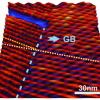
The Nanoscale Physics Group
Instituto de Ciências Exatas e Biológicas
Campus Universitário Morro do Cruzeiro
Latest News
- Professores da UFOP publicam livro de poesias com arrecadação destinada à ONG de resgate animal
- Chamada para bolsa de pós-doutorado em Física e/ou Física de Materiais
- EDITAL PÓS-DOC 2022 - CAPES FIMAT
- Professora Ive Silvestre participa do podcast
- Segunda Temporada HPCSpotlight
- Processo Seletivo do Mestrado em Ciências com ênfase em Física de Materiais 2020/2
Filtrar notícias por mês
- Julho 2017 (1)
- Novembro 2016 (1)
- Outubro 2016 (2)
- Junho 2016 (3)
- Abril 2016 (4)
Copyright © 2025 Universidade Federal de Ouro Preto
